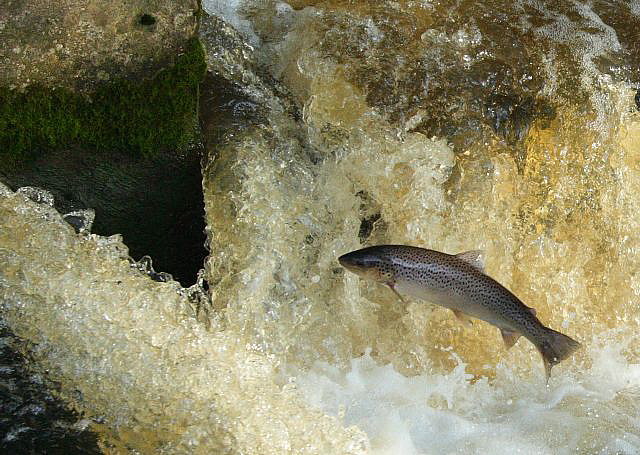There are trout along the Sid:
As confirmed this autumn by the West Country Rivers Trust:
The Environment Agency recently described the River Sid as a rare habitat with such a lot of potential; this is due to its active gravel system that is loved by many types of fish. Historically, it has been a habitat for both Sea Trout and Atlantic Salmon, however we have been deprived of these species by large weirs impassable to migrating fish.
On the 5th September, two qualified people from the West Country Rivers Trust surveyed the fish population with electrofishing, commissioned by the Sid Valley Biodiversity Group… There were 25 brown trout collected in all, the best site being Sidbury, with nine adults caught; Gilchrist and the Snod also had good numbers. Trout fry were only found in the head waters of the Sid, it is disappointing this was the only location.
‘The West Country Rivers Trust try electrofishing on the Sid’ | Sidmouth Herald

Leaping Sea Trout – geograph.org.uk – 1021829.jpg – Wikimedia Commons
Collecting data is crucial to understanding the state of the river – and fortunately the River Sid is being monitored, unlike other rivers:
North Yorkshire rivers neglected full testing since 2017 | The Northern Echo
The question is whether there will be trout along the Sid in future years:
The past, present and future of trout on the Sid – The Sid
There is increasing concern about the current state and future course of sea trout, aka brown trout:
Sea trout, an iconic and ecologically significant species, are facing challenges across England, Wales, Scotland, and Ireland.
IFM Sea Trout Symposium – Fisheries Society of the British Isles
Last month, the WildFish group and the Wild Trout Trust reported on that symposium:
Sea trout are an anadromous fish, meaning that they are an important proxy for the wider environmental health of our rivers, lakes, estuaries and coastal waters.
The IFM’s closing statements to the symposium aptly summarise the current situation: “The evidence is clear: over the last decade, sea trout numbers have plummeted in rivers throughout England, Wales, Scotland, and Ireland. Barriers to migration, poor water quality, predation, marine exploitation, and climate change were identified as the main causes.”
Attendees agreed that we must stop viewing trout, or even salmonids in isolation and, instead consider them holistically, as part of the wider environmental picture. Viewing trout as a vital part of our aquatic ecosystems will be far more effective than trying to campaign for their protection individually.
A healthy trout population means a healthy river, lake or coastal area. They are indicators of clean, biodiverse waters, which are used increasingly by local communities from wild swimmers to surfers. It is imperative that we capitalise on this heightened public consciousness surrounding water issues and look to introduce the plight of the sea trout into the current discourse. If not, despite our expanding knowledge of the importance and fragility of trout populations, it will be difficult to deliver meaningful change.
Sea Trout: what we know and the challenges to conservation | Wildfish
IFM Sea Trout Symposium 2023: Outcomes and next steps | Wild Trout Trust
